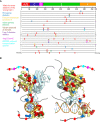Structural insights into the HNF4 biology
- PMID: 37404310
- PMCID: PMC10315846
- DOI: 10.3389/fendo.2023.1197063
Structural insights into the HNF4 biology
Abstract
Hepatocyte Nuclear Factor 4 (HNF4) is a transcription factor (TF) belonging to the nuclear receptor (NR) family that is expressed in liver, kidney, intestine and pancreas. It is a master regulator of liver-specific gene expression, in particular those genes involved in lipid transport and glucose metabolism and is crucial for the cellular differentiation during development. Dysregulation of HNF4 is linked to human diseases, such as type I diabetes (MODY1) and hemophilia. Here, we review the structures of the isolated HNF4 DNA binding domain (DBD) and ligand binding domain (LBD) and that of the multidomain receptor and compare them with the structures of other NRs. We will further discuss the biology of the HNF4α receptors from a structural perspective, in particular the effect of pathological mutations and of functionally critical post-translational modifications on the structure-function of the receptor.
Keywords: DNA Allostery; HNF4; MODY1; hepatocyte nuclear factor 4; nuclear receptors; protein-DNA complexes; structural biology; transcription.
Copyright © 2023 Beinsteiner, Billas and Moras.
Conflict of interest statement
The authors declare that the research was conducted in the absence of any commercial or financial relationships that could be construed as a potential conflict of interest.
Figures







Similar articles
-
MODY1 mutation Q268X in hepatocyte nuclear factor 4alpha allows for dimerization in solution but causes abnormal subcellular localization.Diabetes. 1998 Jun;47(6):985-90. doi: 10.2337/diabetes.47.6.985. Diabetes. 1998. PMID: 9604881
-
Analysis of protein dimerization and ligand binding of orphan receptor HNF4alpha.J Mol Biol. 2000 Sep 29;302(4):831-51. doi: 10.1006/jmbi.2000.4099. J Mol Biol. 2000. PMID: 10993727
-
Control of Cell Identity by the Nuclear Receptor HNF4 in Organ Pathophysiology.Cells. 2020 Sep 28;9(10):2185. doi: 10.3390/cells9102185. Cells. 2020. PMID: 32998360 Free PMC article. Review.
-
Inhibitor of the tissue-specific transcription factor HNF4, a potential regulator in early Xenopus development.Mol Cell Biol. 2000 Dec;20(23):8676-83. doi: 10.1128/MCB.20.23.8676-8683.2000. Mol Cell Biol. 2000. PMID: 11073969 Free PMC article.
-
HNF4α--role in drug metabolism and potential drug target?Curr Opin Pharmacol. 2010 Dec;10(6):698-705. doi: 10.1016/j.coph.2010.08.010. Curr Opin Pharmacol. 2010. PMID: 20833107 Free PMC article. Review.
Cited by
-
HNF4α isoforms: the fraternal twin master regulators of liver function.Front Endocrinol (Lausanne). 2023 Aug 3;14:1226173. doi: 10.3389/fendo.2023.1226173. eCollection 2023. Front Endocrinol (Lausanne). 2023. PMID: 37600688 Free PMC article. Review.
-
Multiple roles and regulatory mechanisms of the transcription factor HNF4 in the intestine.Front Endocrinol (Lausanne). 2023 Aug 10;14:1232569. doi: 10.3389/fendo.2023.1232569. eCollection 2023. Front Endocrinol (Lausanne). 2023. PMID: 37635981 Free PMC article. Review.
-
Leupaxin promotes hepatic gluconeogenesis and glucose metabolism by coactivation with hepatic nuclear factor 4α.Mol Metab. 2025 Jan;91:102075. doi: 10.1016/j.molmet.2024.102075. Epub 2024 Nov 26. Mol Metab. 2025. PMID: 39603504 Free PMC article.
-
Hepatocyte nuclear factor 4 located in different developmental stages of Schistosoma japonicum and involved in important metabolic pathways.Biomed J. 2025 Feb;48(1):100726. doi: 10.1016/j.bj.2024.100726. Epub 2024 Apr 16. Biomed J. 2025. PMID: 38621646 Free PMC article.
-
Hepatocyte Nuclear Factor 4 Alpha: A Key Regulator of Liver Disease Pathology and Haemostatic Disorders.Liver Int. 2025 Jun;45(6):e16245. doi: 10.1111/liv.16245. Liver Int. 2025. PMID: 40387433 Review.
References
-
- Xanthopoulos KG, Prezioso VR, Chen WS, Sladek FM, Cortese R, Darnell JE. The different tissue transcription patterns of genes for HNF-1, C/EBP, HNF-3, and HNF-4, protein factors that govern liver-specific transcription. Proc Natl Acad Sci (1991) 88:3807–11. doi: 10.1073/pnas.88.9.3807 - DOI - PMC - PubMed
-
- Mietus-Snyder M, Sladek FM, Ginsburg GS, Kuo CF, Ladias JA, Darnell JE, Jr, et al. . Antagonism between apolipoprotein AI regulatory protein 1, Ear3/COUP-TF, and hepatocyte nuclear factor 4 modulates apolipoprotein CIII gene expression in liver and intestinal cells. Mol Cell Biol (1992) 12:1708–18. doi: 10.1128/mcb.12.4.1708-1718.1992 - DOI - PMC - PubMed
Publication types
MeSH terms
Substances
LinkOut - more resources
Full Text Sources
Miscellaneous

